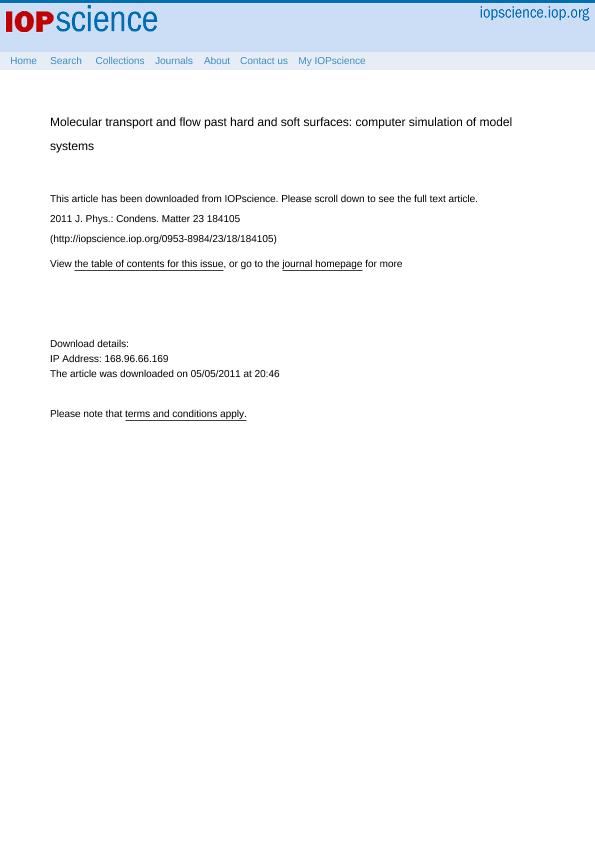Mostrar el registro sencillo del ítem
dc.contributor.author
Léonforte, F.
dc.contributor.author
Servantie, J.
dc.contributor.author
Pastorino, Claudio

dc.contributor.author
Müller, M.
dc.date.available
2023-02-24T17:28:09Z
dc.date.issued
2011-04
dc.identifier.citation
Léonforte, F.; Servantie, J.; Pastorino, Claudio; Müller, M.; Molecular transport and flow past hard and soft surfaces: Computer simulation of model systems; IOP Publishing; Journal of Physics: Condensed Matter; 23; 18; 4-2011; 1-22
dc.identifier.issn
0953-8984
dc.identifier.uri
http://hdl.handle.net/11336/188816
dc.description.abstract
The equilibrium and flow of polymer films and drops past a surface are characterized by the interface and surface tensions, viscosity, slip length and hydrodynamic boundary position. These parameters of the continuum description are extracted from molecular simulations of coarse-grained models. Hard, corrugated substrates are modelled by a Lennard-Jones solid while polymer brushes are studied as prototypes of soft, deformable surfaces. Four observations are discussed. (i)If the surface becomes strongly attractive or is coated with a brush, the Navier boundary condition fails to describe the effect of the surface independently of the strength and type of the flow. This failure stems from the formation of a boundary layer with an effective, higher viscosity. (ii)In the case of brush-coated surfaces, flow induces a cyclic, tumbling motion of the tethered chain molecules. Their collective motion gives rise to an inversion of the flow in the vicinity of the grafting surfaces and leads to strong, non-Gaussian fluctuations of the molecular orientations. The flow past a polymer brush cannot be described by Brinkman's equation. (iii)The hydrodynamic boundary condition is an important parameter for predicting the motion of polymer droplets on a surface under the influence of an external force. Their steady-state velocity is dictated by a balance between the power that is provided by the external force and the dissipation. If there is slippage at the liquid-solid interface, the friction at the solid-liquid interface and the viscous dissipation of the flow inside the drop will be the dominant dissipation mechanisms; dissipation at the three-phase contact line appears to be less important on a hard surface. (iv)On a soft, deformable substrate like a polymer brush, we observe a lifting-up of the three-phase contact line. Controlling the grafting density and the incompatibility between the brush and the polymer liquid we can independently tune the softness of the surface and the contact angle and thereby identify the parameters for maximizing the deformation at the three-phase contact.
dc.format
application/pdf
dc.language.iso
eng
dc.publisher
IOP Publishing

dc.rights
info:eu-repo/semantics/openAccess
dc.rights.uri
https://creativecommons.org/licenses/by-nc-sa/2.5/ar/
dc.subject
Liquid-solid interfaces
dc.subject
Polymers
dc.subject
Soft matter
dc.subject.classification
Física de los Materiales Condensados

dc.subject.classification
Ciencias Físicas

dc.subject.classification
CIENCIAS NATURALES Y EXACTAS

dc.title
Molecular transport and flow past hard and soft surfaces: Computer simulation of model systems
dc.type
info:eu-repo/semantics/article
dc.type
info:ar-repo/semantics/artículo
dc.type
info:eu-repo/semantics/publishedVersion
dc.date.updated
2023-02-21T22:17:52Z
dc.journal.volume
23
dc.journal.number
18
dc.journal.pagination
1-22
dc.journal.pais
Reino Unido

dc.journal.ciudad
Londres
dc.description.fil
Fil: Léonforte, F.. Universität Göttingen; Alemania
dc.description.fil
Fil: Servantie, J.. Universität Göttingen; Alemania
dc.description.fil
Fil: Pastorino, Claudio. Comisión Nacional de Energía Atómica. Centro Atómico Constituyentes; Argentina. Consejo Nacional de Investigaciones Científicas y Técnicas; Argentina
dc.description.fil
Fil: Müller, M.. Universität Göttingen; Alemania
dc.journal.title
Journal of Physics: Condensed Matter

dc.relation.alternativeid
info:eu-repo/semantics/altIdentifier/url/http://iopscience.iop.org/0953-8984/23/18/184105/
dc.relation.alternativeid
info:eu-repo/semantics/altIdentifier/doi/http://dx.doi.org/10.1088/0953-8984/23/18/184105
Archivos asociados
